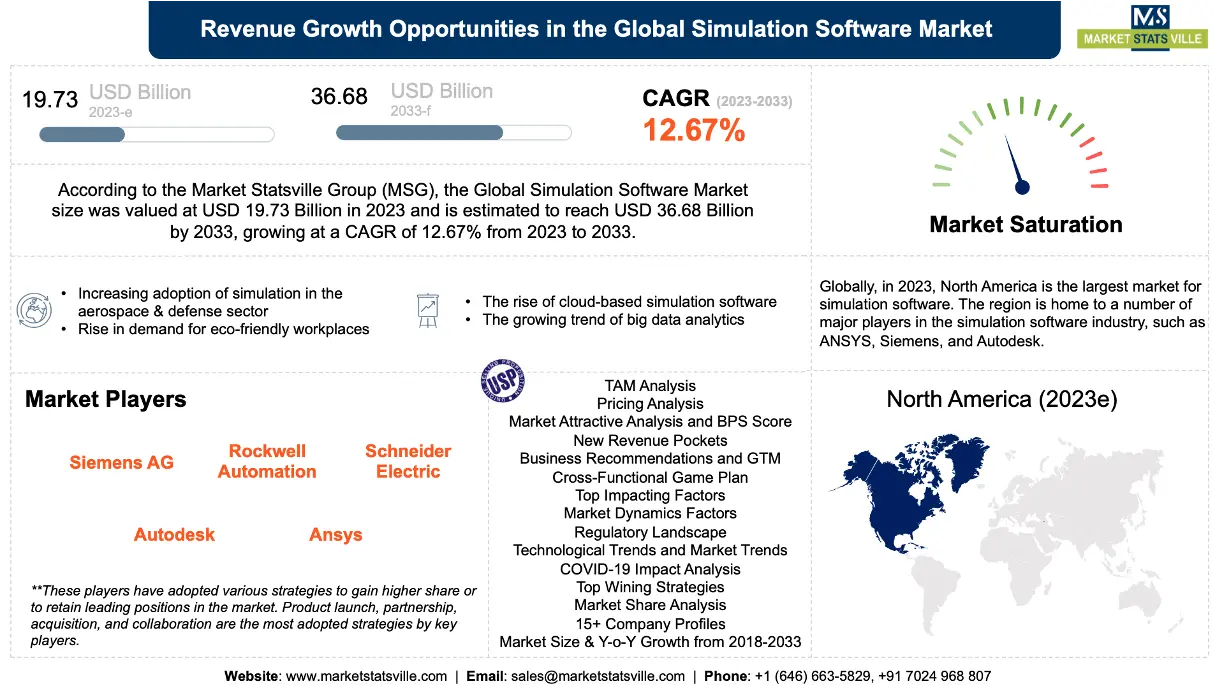According to the Market Statsville Group (MSG), the Global Simulation Software Market size was valued at USD 19.73 Billion in 2023 and is estimated to reach USD 36.68 Billion by 2033, growing at a CAGR of 12.67% from 2023 to 2033.
The growth of the market is driven by the increasing adoption of simulation in the aerospace & defense sector, the rise in demand for eco-friendly workplaces, and the surge in the use of simulation software for the automotive and healthcare industries.

To know more about the global simulation software market, download free PDF report here
The global simulation software market refers to the industry that encompasses the development, distribution, and utilization of software applications designed to simulate real-world scenarios and processes. Simulation software enables users to create virtual environments that mimic the behavior and characteristics of physical systems, allowing them to study and analyze complex phenomena without the need for costly and time-consuming real-world experiments.
Simulation software finds applications across various sectors, including manufacturing, healthcare, defense, automotive, aerospace, and many others. It enables organizations to model and evaluate scenarios, test hypotheses, optimize processes, and make informed decisions. By providing a virtual platform for experimentation, simulation software offers a cost-effective and efficient means of assessing the performance, reliability, and safety of systems, products, and processes before their physical implementation.
The market for simulation software has witnessed significant growth in recent years, driven by advancements in computing power, increased demand for product innovation, and the need to reduce time-to-market. Additionally, the rise of emerging technologies such as artificial intelligence, machine learning, and virtual reality has further expanded the capabilities and applications of simulation software.
The COVID-19 pandemic has significantly impacted the global simulation software market, just like it has on many other industries. Although it initially caused disruptions in supply chains and led to a decline in demand for simulation software due to the uncertain economic outlook, it also created new opportunities. As physical interactions and travel became, limited, virtual simulation and modeling became more necessary. This led to an increased demand for simulation software in various sectors like manufacturing, healthcare, aerospace, and automotive, as organizations turned to it to develop virtual prototypes, conduct virtual testing, and optimize their processes remotely.
Additionally, the pandemic accelerated the adoption of digital transformation strategies, causing organizations to invest in simulation software to improve efficiency, reduce costs, and enhance decision-making processes. The global simulation software market has also experienced a shift towards cloud-based solutions, and there have been increased investments in artificial intelligence and machine learning capabilities to improve simulation accuracy and efficiency.
Moving forward, the COVID-19 pandemic has highlighted the importance of simulation software in mitigating risks and navigating uncertainties. As such, the market is expected to grow as industries recognize the value of virtual simulations in preparing for future disruptions and optimizing their operations.
North America is the largest market for simulation software. The region is home to a number of major players in the simulation software industry, such as ANSYS, Siemens, and Autodesk. The region is also home to a number of large and growing industries, such as the automotive, aerospace, and defense industries, which are driving the demand for simulation software.
Europe is the second-largest market for simulation software. The region is home to a number of major players in the simulation software industry, such as Dassault Systèmes, MathWorks, and Altair. The region is also home to a number of large and growing industries, such as the automotive, aerospace, and defense industries, which are driving the demand for simulation software.
Although, Asia Pacific is the fastest-growing market for simulation software. The region is home to a number of large and growing industries, such as the automotive, aerospace, and defense industries, which are driving the demand for simulation software. The region is also home to a number of rising economies, such as China and India, which are investing heavily in simulation software to improve their manufacturing capabilities.
The global simulation software market is highly competitive, with a number of major players vying for market share. The leading players in the market are Siemens AG, Rockwell Automation Inc., Schneider Electric SE, Autodesk Inc., and Ansys. These companies are focusing on developing innovative simulation software devices to meet the growing demand for these devices.

Frequently Asked Questions
The global simulation software market has a untapped growth potential opportunity worth USD 16.95 Billion from 2023 to 2033. The forecasted market size for the simulation software market in 2033 is estimated to be USD 36.68 Billion.
The main players involve in the market are MathWork, Autodesk, Ansys, Siemens AG, PTC, Dassault Systemes, Altair Engineering, MSC Software, Honeywell, Keysight Technologies, Aveva, Spirent Communications, Bentley Systems, Synopsys, AVL List GmbH, COMSOL, Certara, CAE (Presagis), aPriori, PTV Group, AnyLogic, SimScale, Scalable Networks, Simul8 Corporation, FlexSim, MOSIMTEC, Simio, ProSim, Cybernet, Cesim, among others.
Want to Review Complete Market Research Report
Budget constraints? Get in touch with us for special pricing
Request for Special PricingCustomize this Report
Related Reports
High-Speed Data Converter Market 2024: Industry Size, Emerging Trends, Regions, Growth Insights, Opportunities, and Forecast By 2033
Oct 2024Retail Automation Market 2022: Industry Size, Regions, Emerging Trends, Growth Insights, Opportunities, and Forecast By 2030
Mar 2024Mobility As A Service (Maas) Market 2023: Industry Size, Emerging Trends, Regions, Growth Insights, Opportunities, and Forecast By 2033
Mar 2024Web 3.0 Blockchain Market 2022: Industry Size, Emerging Trends, Regions, Growth Insights, Opportunities, and Forecast By 2033
Mar 2024OLED Microdisplay Market 2021: Industry Size, Regions, Emerging Trends, Growth Insights, Opportunities, and Forecast By 2027
Mar 2024